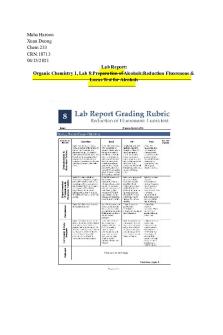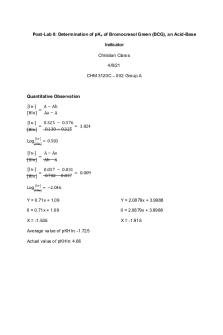Post Lab #8 Determination of Fluoride PDF

| Title | Post Lab #8 Determination of Fluoride |
|---|---|
| Course | Analytical Chemistry |
| Institution | The University of Texas at San Antonio |
| Pages | 8 |
| File Size | 187.2 KB |
| File Type | |
| Total Downloads | 14 |
| Total Views | 153 |
Summary
lab report ...
Description
CHEM 3214-0A1
Post Lab: Potentiometric Determination of Fluoride in Drinking Water using Fluoride IonSelective Electrode 11/1/17
Introduction Ion-selective combination electrode is utilized to determine the concentrations of a specific ion in aqueous solutions such as fluoride. The inner reference electrode is within the ionselective electrode where potential is produced. During this lab experiment fluoride ions can go through meaning they are fluoride ion-selective electrodes. The generated potential is measured versus a constant reference potential with the availability of a fluoride ion-selective electrode amplifier. The produced potential is a function of the difference between the activity of the specific ion on the membrane. The potential that is produced across the membrane is in relationship to the analyte activity solution, when there is a fixed concentration of the analyte ions in the solution. Topics of thermodynamics are important to be revisited to understand chemical potentials; during this lab experiment the Nernst equation is utilized; E = E0 – S log X. This equation relates the reduction potential of an electrochemical reaction to the standard electrode potential, activities, and temperatures. E is the measured electrode potential, E0 is the reference potential which is a constant. S represents the electrode slope, and X is the level of fluoride ions in each solution. X can be presented as the effective concentration of free fluoride ions in a solution. The Nernst equation is most utilized for dilute solutions when the ionic strength remains constant. The total ionic-strength adjustment buffer (TISAB) is used to adjust the conditions of this solution. TISAB buffer solution is a high ionic strength and works so that fluoride ion concentrations may be lowered from measurement of fluoride. TISAB also works to decrease the influence of polyvalent cations that may create complexes along with fluoride. In this lab experiment, seven solutions will be measured, including a blank. These seven solutions will be diluted with DI water and the absorbance will be measured as the concentrations are diluted using UV vis and Spec 20. These devices are ion selective sensors that will specifically search for fluoride ions. The potential that is produced from the chemical potentials (E0 ) will be measured of the electrical energy that is being generated due to a electrochemical gradient that is happening in the process. A calibration will be prepared for this experiment.
Materials
Burette
Hot plate
125 mL flask
250 mL volumetric flask
Analytical balance
Micropipette
Hazards and Safety (MSDS) Chemical Name
Chemical Formula
Molecular Mass (g/mol)
Melting Point (°C)
Boiling Point (°C)
Hazards
Water
H 2O
18.02
0
100
-Non-hazardous
NaOH
NaOH
39.997
318
1,388
-Irritant of skin, eye, inhalation, and ingestion -Corrosive -May cause burns
Acetic Acid
CH3COOH
60.05
16-17
118-119
-Irritant of skin, eye, inhalation, and ingestion -Corrosive -Mutagenic for mammalian somatic cells
Sodium Flouride
NaF
41.9882
993
1695
-Irritant of skin, eye, inhalation, and ingestion - Mutagenic for mammalian somatic cells
-Corrosive in case of skin contact -toxic to kidneys, lungs, CNS, heart, GI Tract, bones, teeth [Na+][Cl-]
NaCl
58.44
801
1,413
-Slight irritant of skin, eye, inhalation, and ingestion -When heated to decomposition it emits toxic fumes
Methods To Prepare: 1. Prepare stock standard 0.1 M solution. 2. Prepare linearity standards with distilled DI H2O series of 10-2, 10-3, 10-4, 10-5, 10-6 M fluoride. 3. A calibration curve will be prepared using concentrations of fluoride to bracket unknown. 4. Prepare additional calibration standards of 2 × 103 and 4 × 103 M fluoride. Determination of range of response and range of linearity: 1. Connect electrode leads to an expanded-scale pH meter. 2. Add with a pipette 10 mL of the 10-6 M standard solution and a 10 mL TISAB solution to small beaker. 3. Place electrode in beaker and utilize magnetic stir rods. 4. Record pH readings when reading is steady. 5. Rinse and blot the electrode and repeat from dilute to concentrated standard solutions. 6. Prepare a spreadsheet of data and charge mV vs. log C. 7. Report slope in mV/decade, the intercept, and the r2, as well as range of linearity. Standardization for unknown:
1. Record readings of the standard solution from 1 × 10-3 and 1 × 10-2 2. Plot a calibration curve as above over this range. 3. Enter the formula in one cell for calculating unknown concentration from millivolt reading, slope and intercept of calibration curve. Analysis of unknown: 1. Obtain unknown fluoride sample. 2. Dilute to volume with DI H2O and transfer to polyethylene bottle. 3. Add 10 mL of unknown with a pipet to a small plastic beaker followed by 10 mL TISAB. 4. Record mV readings as above, and conduct three trials. 5. Determine concentration of fluoride in the unknown solution from the calibration curves. 6. Report data in ppm fluoride, along with the standard deviation.
Data and Calculations Table 1. Stock Solutions and Conductivity Serial #: TT1-13878 Dilute of 0.1 M NaF
Potential (mV)
Log [C]
-2
-12.3 mV
-2
-3
4x10 mL
6.6 mV
-2.40
2x10-3 mL
25.2 mV
-2.70
1x10-3 mL
46.9 mV
-3
1x10 mL
1x10-4 mL
100.3 mV
-4
1x10 mL
144.4 mV
-5
1x10-6 mL
175.8 mV
-6
Unknown
-14.0 mV
?
-5
Graph 1. Log [C] vs. mV
Log [C] vs. mV 200 150
mV
100 50
-6.5
-6
-5.5
-5
-4.5
-4
-3.5
-3
-2.5
-2
0 -1.5 -50
Log [C]
Electrode Serial #
mV -14.0
Group 1: TT1-13863
-19.5
Group 2: TU1-16278
-17.36
Average
-16.95
Standard Deviation
2.77
Calculations: Y=-48.442x-104.14 -14=-48.442x-104.14 -14+104.14=-48.442x 90.14/-48.442=x -1.86=x 10-1.86= 0.0138M
Conclusion/Discussion It is important to revise topics of Thermodynamics in order to understand the Nernst equation and how this relates to chemical potentials. Nernst equation relates reduction potential of an electrochemical reaction to the standard electrode potential, temperature, and activities. Keq is the equilibrium constant when products over reactants are all raised to their coefficients. K eq is at equilibrium, but when a system is not at equilibrium the reaction quotient is utilized instead.
When Q is less than Keq the reaction shifts to the right. When Q is greater than Keq the reaction shifts to the left. When Q = K, equilibrium has been reached. During this lab experiment the cell potentials were measured in mV as a function of the concentration of the Fluoride anion. As the data collected shows, as fluoride increases so does the cell potential. In addition, our group used Fisher to measure the cell potential for these solutions. The electrode is utilized to only register fluoride anions and should be only used in aqueous solutions. The addition of TISAB before the solution before the measurement keeps the pH value and the ionic strength constant. TISAB contains an acetic acid/acetate buffer that changes pH. The TISAB buffer is utilized to decrease the influence of polyvalent cations that may form complexes with fluoride within the solution; adjust conditions. In addition, TISAB buffer is high in ionic strength and functions so that fluoride ion concentrations may be decreased from measurement of fluoride. The reason plastic is used over glass is because glass can influence the fluoride structure due to spectroscopy. The calculated concentration of the fluoride ions for this lab experiment was 0.0138 M. The average was -16.95 with a standard deviation of 2.77. As the volume of dilute increase, the cell potential value goes to 0 because the standard is 0.1 M. Determination of fluoride ions is important in real world applications like finding concentrations of fluoride in the human body and in the environment as well since they can be harmful to the environment and the human body as well....
Similar Free PDFs

Post lab 8 - lab 8
- 7 Pages

ORGO 2 POST LAB 8 - POST LAB
- 14 Pages

Post Lab 8 multi step
- 6 Pages

Experiment 8 Post-Lab Report
- 15 Pages

Orgo Post-lab 8 - Orgo- Lab report
- 14 Pages

Post lab - Post Lab 1
- 2 Pages

Oxygen fluoride
- 4 Pages

Post lab 2 - post lab orton
- 8 Pages
Popular Institutions
- Tinajero National High School - Annex
- Politeknik Caltex Riau
- Yokohama City University
- SGT University
- University of Al-Qadisiyah
- Divine Word College of Vigan
- Techniek College Rotterdam
- Universidade de Santiago
- Universiti Teknologi MARA Cawangan Johor Kampus Pasir Gudang
- Poltekkes Kemenkes Yogyakarta
- Baguio City National High School
- Colegio san marcos
- preparatoria uno
- Centro de Bachillerato Tecnológico Industrial y de Servicios No. 107
- Dalian Maritime University
- Quang Trung Secondary School
- Colegio Tecnológico en Informática
- Corporación Regional de Educación Superior
- Grupo CEDVA
- Dar Al Uloom University
- Centro de Estudios Preuniversitarios de la Universidad Nacional de Ingeniería
- 上智大学
- Aakash International School, Nuna Majara
- San Felipe Neri Catholic School
- Kang Chiao International School - New Taipei City
- Misamis Occidental National High School
- Institución Educativa Escuela Normal Juan Ladrilleros
- Kolehiyo ng Pantukan
- Batanes State College
- Instituto Continental
- Sekolah Menengah Kejuruan Kesehatan Kaltara (Tarakan)
- Colegio de La Inmaculada Concepcion - Cebu







